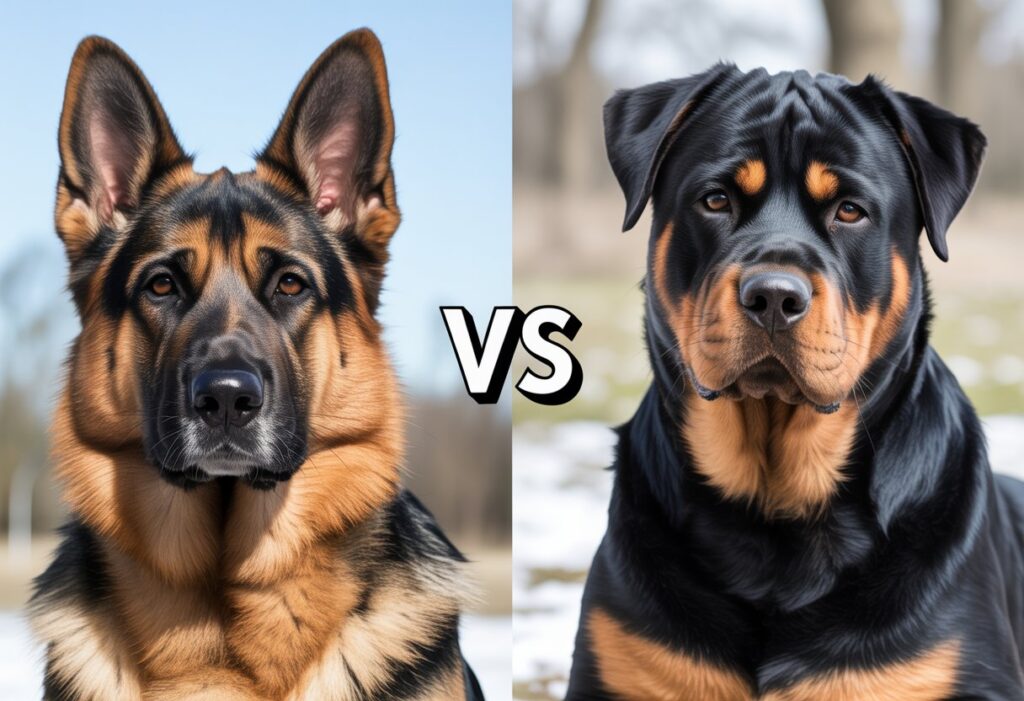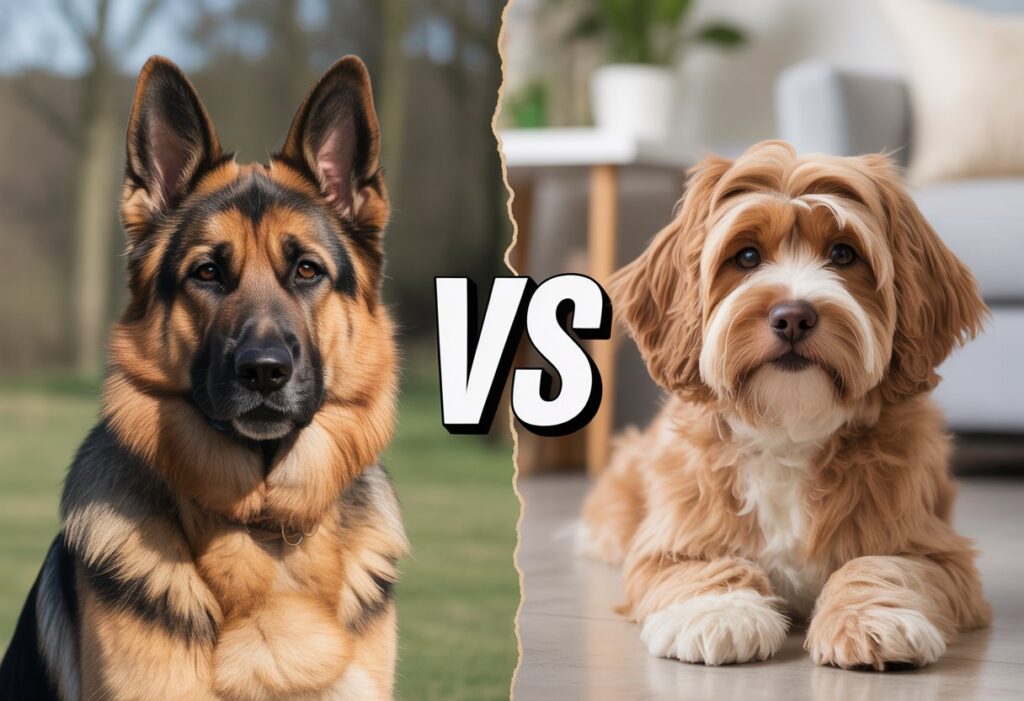Choosing between a German Shepherd and a Rottweiler isn’t easy, especially if you want a smart, loyal, protective dog. German Shepherds are usually easier to train and more eager to please, while Rottweilers are powerful and confident with a strong guarding instinct.
Both breeds have their strengths, but their personalities and needs are pretty different.
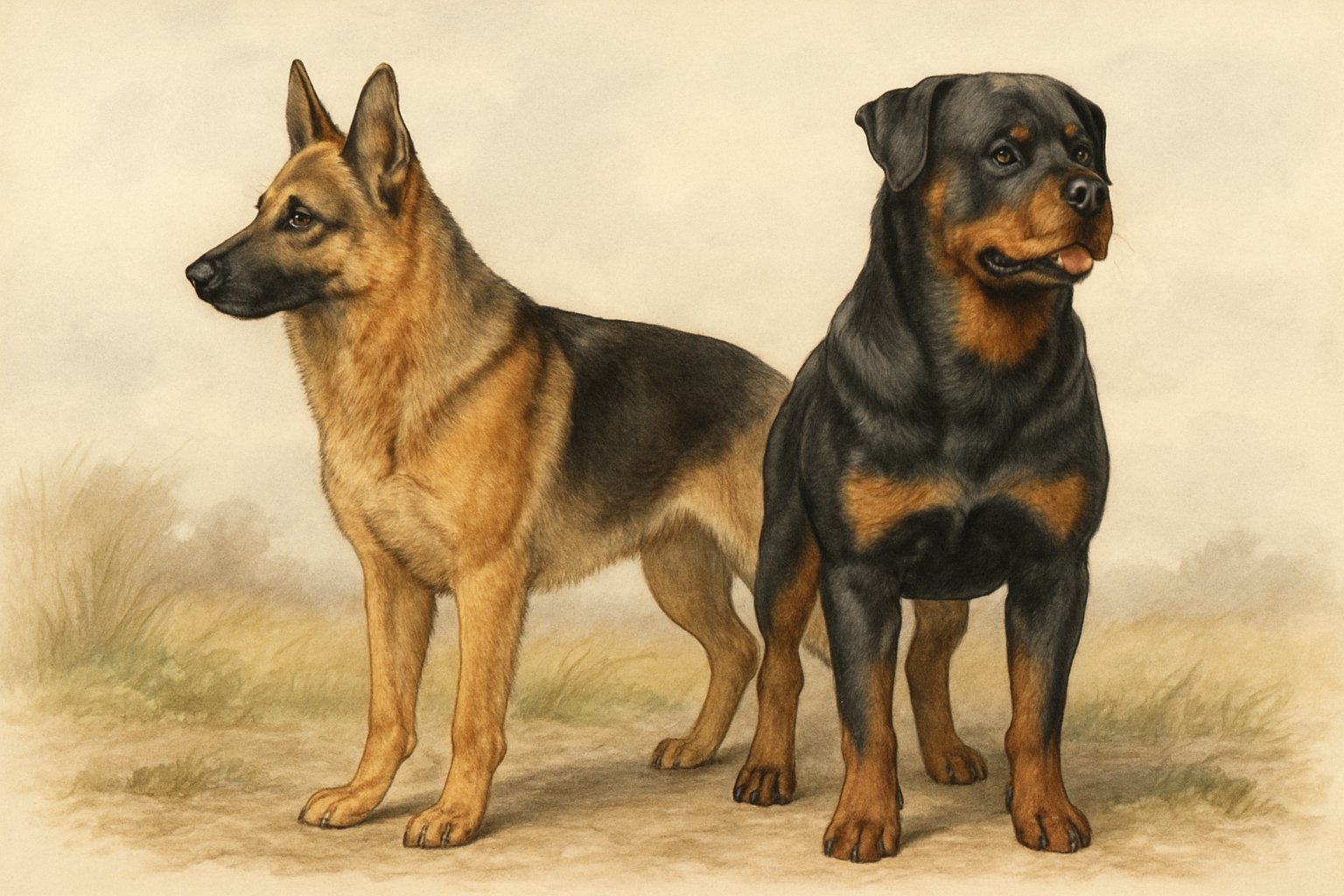
If you’re looking for a family companion, guard dog, or working partner, it helps to know what makes each breed unique. This comparison should point you toward the right fit for your home and lifestyle.
Key Takeaways
- German Shepherds and Rottweilers come from different backgrounds and have different builds.
- Their personalities and care needs aren’t the same and suit different kinds of owners.
- Both breeds are strong, smart, and need good training and attention.
Breed Origins and History
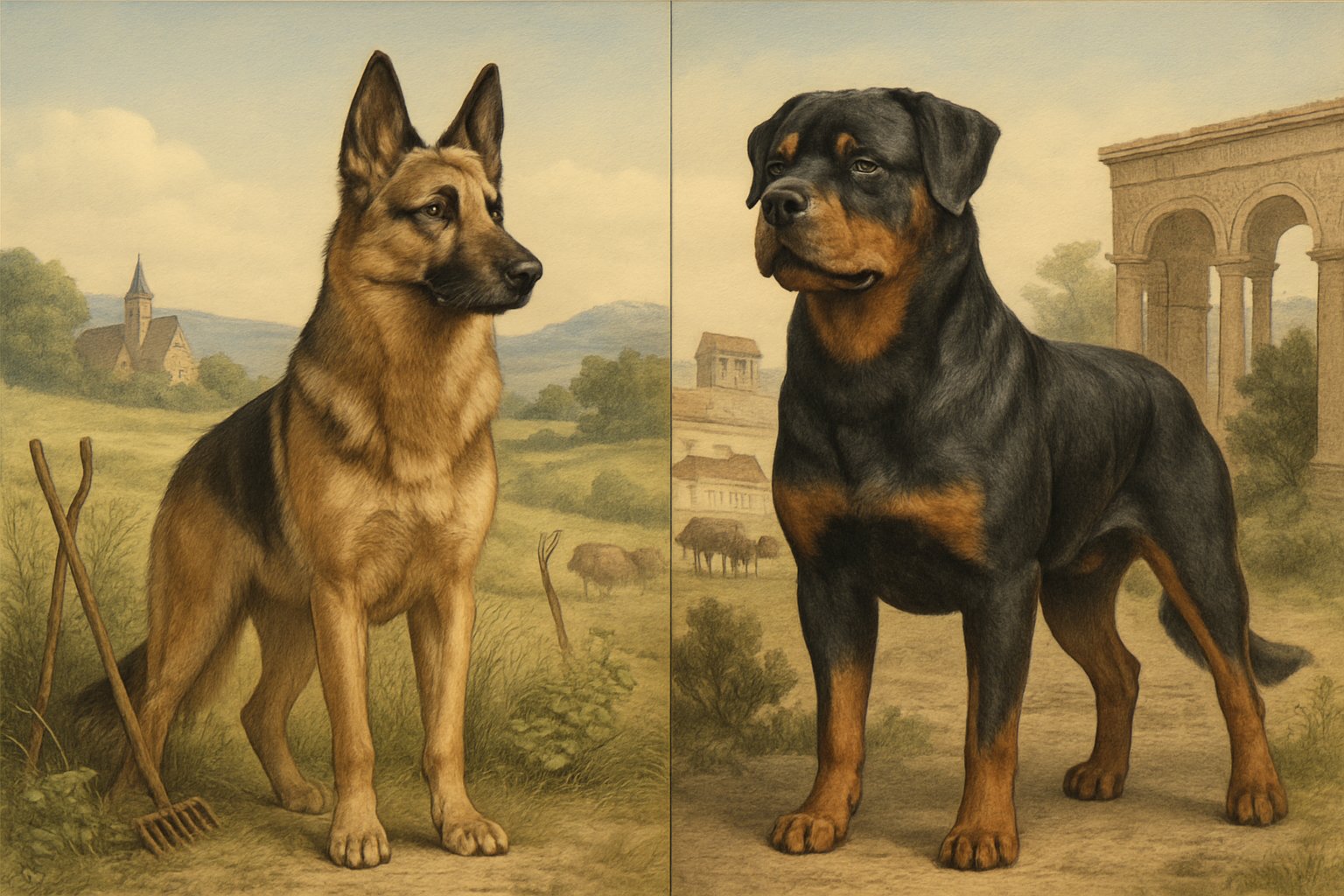
The German Shepherd and Rottweiler each have a rich past shaped by their original jobs and environments. Their histories explain a lot about their skills, temperaments, and looks.
German Shepherd Background
German Shepherds were first bred in Germany in the late 1800s. Captain Max von Stephanitz wanted a smart, strong, loyal dog for herding sheep and guarding farms.
He crossed several herding breeds and eventually created the German Shepherd. Early German Shepherds stood out for their intelligence, bravery, and focus.
People quickly noticed how well they followed commands and worked long hours. After proving themselves as herding dogs, they served in the military and police during World War I and II.
Today, German Shepherds are famous for loyalty, sharp minds, and versatility. You’ll see them as police dogs, service animals, and family pets.
Their energetic, trainable, and protective nature really comes from their roots.
Rottweiler Heritage
Rottweilers are among the oldest working breeds. Their story goes all the way back to the Roman Empire.
Roman soldiers used them as drover dogs to move cattle across Europe. Later, the breed settled in Rottweil, Germany, which is how they got their name.
They became known as “butcher’s dogs.” Rottweilers would pull carts loaded with meat, guard money, and protect owners from thieves.
They earned a reputation for being strong, steady, and fearless. Today, you’ll find both American Rottweilers and German Rottweilers.
German Rottweilers are usually bred under strict ADRK rules focusing on health and character. Both types are powerful and loyal, but German bloodlines often stick closer to the traditional standard.
Comparison to Related Breeds
People often compare German Shepherds to the Belgian Malinois and Akita, since those breeds are also smart and protective. The Malinois, like the Shepherd, is popular in police and military work.
Rottweilers share roots with mastiff-type breeds like the Cane Corso. They’re similar in strength and guarding ability to the Doberman Pinscher and even the Chow Chow.
Some of these related breeds are more independent or guard in different ways. Every breed was designed for a purpose.
Knowing their origins helps you pick a breed that matches your lifestyle and needs.
Physical Characteristics
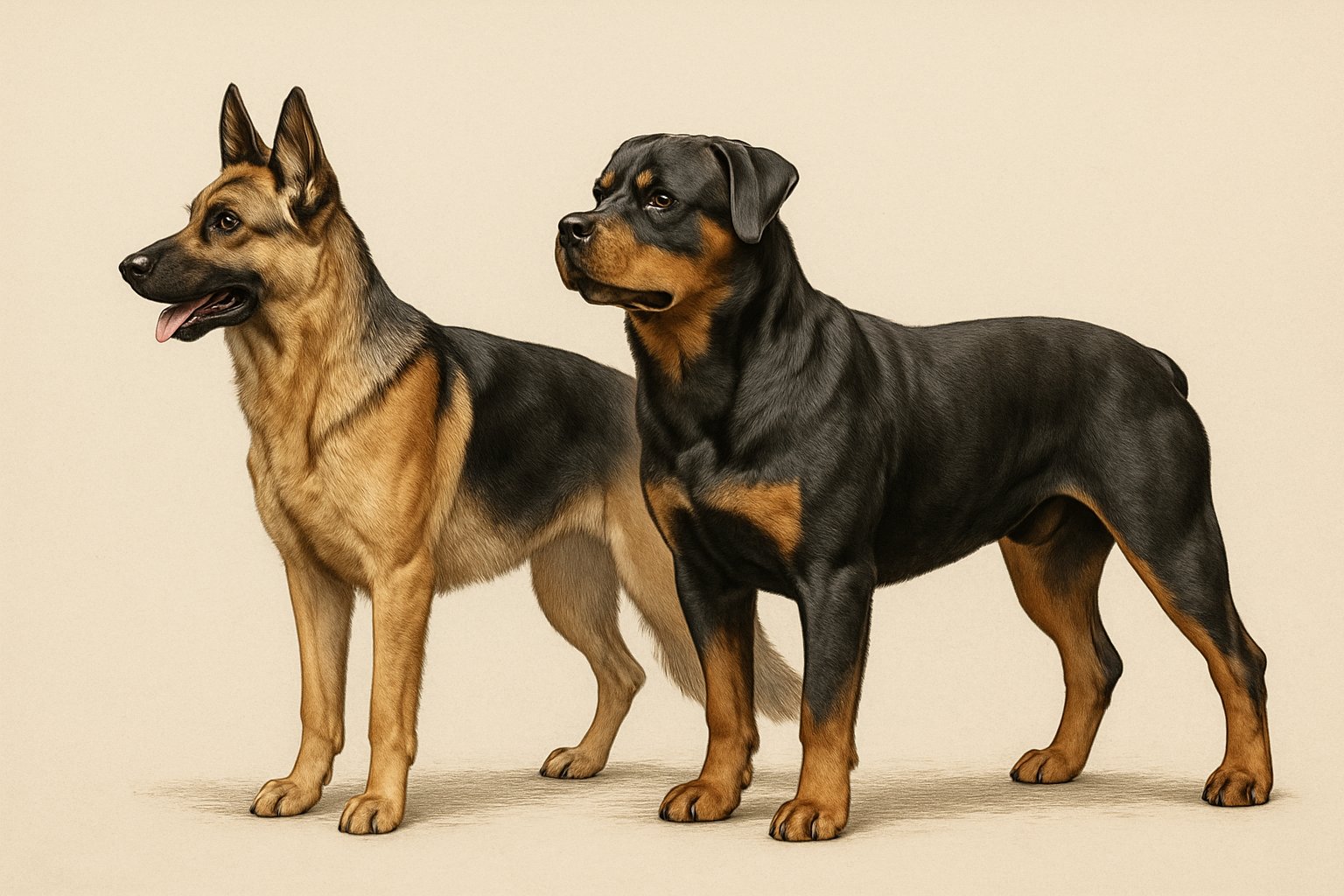
German Shepherds and Rottweilers are both large dogs, but they look and move differently. Each breed’s traits can help you decide which one fits your preferences.
Size and Appearance
German Shepherds usually weigh 50–90 pounds and stand 22–26 inches tall at the shoulder. Their bodies are long and muscular, with a straight back—though some show lines have a more sloped back.
Rottweilers are heavier, weighing 80–135 pounds and standing 22–27 inches tall. They’ve got a stockier build and broad chest, making them look strong and boxy.
Their heads are blocky with a short, straight muzzle. Both breeds have a double coat.
German Shepherds have medium-length fur that’s straight or a bit wavy. Rottweilers have short, dense hair.
Color-wise, German Shepherds are often black and tan. Rottweilers are almost always black with rust markings above the eyes, on the chest, and legs.
| Breed | Weight (lbs) | Height (inches) | Main Colors | Coat Type |
|---|---|---|---|---|
| German Shepherd | 50–90 | 22–26 | Black & tan | Medium, double |
| Rottweiler | 80–135 | 22–27 | Black & rust | Short, double |
Breed Standards
Groups like the American Kennel Club (AKC) and the German Shepherd Dog Club of America set breed standards. For German Shepherds, the goal is a noble, well-proportioned dog with a confident, alert look.
Their movement should be smooth and steady. Rottweilers are supposed to look robust and powerful.
The AKC describes Rottweilers as medium to large, with a compact, muscular build. Broad heads, strong necks, and tight lips matter.
Both breeds should have straight legs, strong paws, and a level topline. Things like overly sloped backs in German Shepherds or narrow bodies in Rottweilers don’t meet the standard.
Special features, like the black saddle marking on German Shepherds or the distinct tan points on Rottweilers, are important for the breed look.
German vs American Variations
German Shepherds bred in Germany are usually working dogs with strict health and temperament rules. They’re often a bit bigger and have straighter backs than American lines.
In the U.S., Shepherds are often bred for shows, which can lead to a more sloped back and flashier movement. Rottweilers also differ by where they’re from.
The German Rottweiler is usually stockier and bred for work. To be registered in Germany, they have to pass tough tests for temperament and physical ability.
The American Rottweiler is still big and strong but often has a slightly lighter frame and looser breed restrictions. Both breeds are a lot bigger than many family dogs, but smaller than giants like the Great Dane or Bernese Mountain Dog.
If you want a certain type, check with breeders or clubs.
Temperament and Behavior
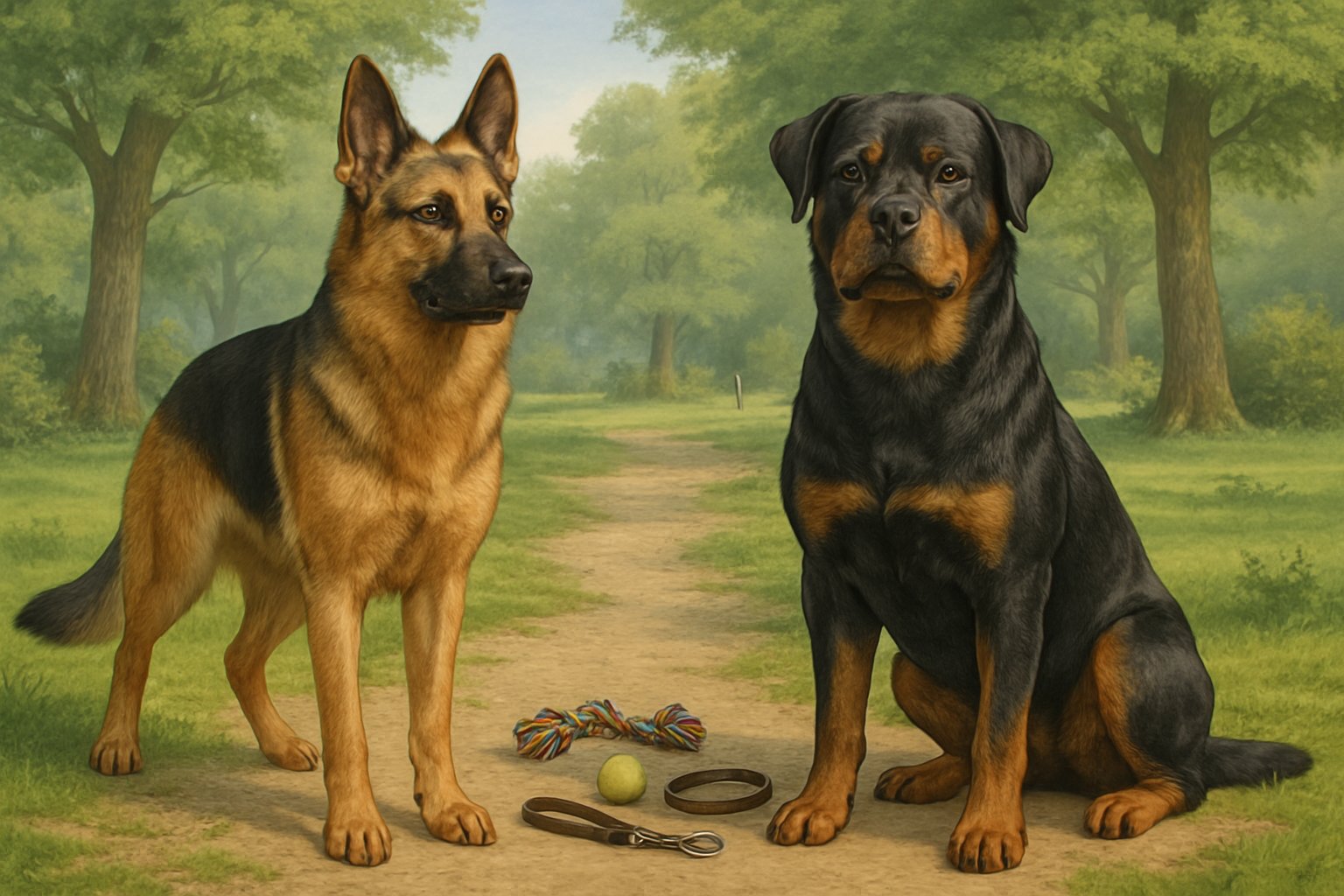
German Shepherds and Rottweilers both have strong personalities, but they act pretty differently at home and around other pets. Their loyalty, guarding skills, and social needs really shape how they fit into family life.
Family Compatibility
German Shepherds are famous for sticking close to their families. They like being near you and can be gentle with kids if you teach them proper manners.
Sometimes they’re reserved with strangers, but they usually warm up after a bit. Rottweilers also bond closely with their people and can be very loving.
They might be a bit more stubborn than a Lab or Collie, so early training helps a lot. Rottweilers need clear rules and strong, fair leadership to behave well in busy homes.
Both breeds can be good family dogs, but Rottweilers are better for families with older children and experienced owners. German Shepherds usually do well with kids of all ages, similar to a Boston Terrier, if they’re socialized early.
Always supervise any dog around young children—accidents can happen.
Protective Instinct and Guarding
German Shepherds are used worldwide as guard dogs because they’re alert and quick to react. They pay attention to the house and yard, barking when someone comes close.
Their protective instinct is strong, but most won’t get aggressive unless trained to be working guard dogs. Rottweilers have a more powerful guarding instinct.
They might act suspicious around new people, so you need to teach them what’s normal and what’s a real threat. Rottweilers can be calmer than some pit bulls, but their protective streak means they need careful socialization and an experienced owner.
Both breeds are much more likely to guard than Labradors or Boston Terriers. Expect them to be watchful and alert, but they need training and clear rules to behave the right way.
Interaction With Other Dogs
German Shepherds usually get along with other dogs if you socialize them early, especially if you introduce them to different breeds like Collies or Labradors. Some males might act dominant, so teaching good manners is important.
Rottweilers are sometimes less tolerant of new dogs, especially those of the same sex. Some lines have a high drive to protect their family or territory from unfamiliar dogs, which is stronger than in many breeds.
Supervised, slow introductions help. Both breeds can live with other dogs, but they need ongoing socialization.
Unlike Boston Terriers or Labs, who are usually happy to make new friends, you’ll need more patience and training to help these two breeds feel comfortable in a multi-dog home.
Training and Exercise Requirements
German Shepherds and Rottweilers are strong, smart dogs who need clear training, lots of exercise, and things that challenge their minds. If you meet these needs, you’ll have a happy, well-behaved pet.
Obedience and Intelligence
Both breeds are known for their intelligence. German Shepherds are often compared to Border Collies and Golden Retrievers for how quickly they learn.
Rottweilers learn fast too, but they might need firmer leadership. Positive reinforcement—treats and praise—works well for both.
Early training really matters to prevent stubborn habits and encourage good manners. Start with simple commands like sit, stay, and come before moving on to harder stuff.
Some owners use clickers, which can work great. Keep training sessions short and daily to hold their attention.
Rottweilers may test your authority more than Shepherds, so it helps to be confident and fair.
Socialization and Mental Stimulation
Both breeds need socialization from a young age. This helps prevent shyness or aggression toward strangers, kids, and other animals.
Let them meet new people, go on safe outings, and have polite introductions to other dogs. Mental stimulation is just as important.
German Shepherds and Rottweilers get bored if left alone or without something to do. Puzzle toys, basic agility, and games like fetch are good options.
Hide-and-seek with treats or toys challenges their brains and keeps them busy. You can use interactive toys like KONGs or food-dispensing balls when you’re busy.
Training sessions also double as mental workouts. If they don’t get enough stimulation, both breeds might start chewing or barking too much.
Exercise Needs
Both breeds need a lot of exercise—at least 1–2 hours each day. Walks, runs, playtime, and structured training all count.
Some breeds, like Siberian Huskies, need even more because of their working background. These dogs like to have a job, whether it’s carrying a backpack on walks or joining canine sports.
Off-leash play in a safe, fenced area is great for burning energy. Without enough exercise, both breeds can get restless or destructive.
Try to mix up activities to keep things interesting. Daily walks, fetch, and running in the yard help them stay healthy and happy.
Keeping their minds and bodies active really makes all the difference.
Health and Care Considerations
German Shepherds and Rottweilers both need regular care to stay healthy. Each breed faces certain health risks, grooming demands, and dietary needs that you’ll want to keep an eye on.
Common Health Issues
German Shepherds often deal with hip and elbow dysplasia. This can cause pain and make it tough for them to get around.
They’re also at risk for digestive issues like bloat. Some even develop degenerative myelopathy, a disease that hits the spinal cord.
Rottweilers can get hip and elbow dysplasia too. They’re also more likely than, say, a Boxer or Chihuahua to develop heart problems like aortic stenosis.
Certain cancers show up more in Rottweilers. Both breeds can face arthritis as they get older.
Schedule routine vet visits, keep up with vaccinations, and run health screenings when needed. Catching issues early makes a real difference.
Diet and Nutrition
German Shepherds need a balanced diet with plenty of protein and a moderate amount of fat. This keeps their muscles strong and their energy up.
Their stomachs can be sensitive, so foods that are easy to digest usually work better. You might need to try a few brands to find what sits well with your dog.
Rottweilers do best with lean proteins and healthy fats to support their muscle and joint health. They gain weight fast if you overfeed them, so it’s smart to measure meals and go easy on the treats.
Both breeds always need access to fresh water. Ask your vet about the best diet and portions for your dog.
Supplements like glucosamine can help protect joints, especially as your dog ages. Not every dog needs them, but it’s worth asking about.
Grooming Needs
German Shepherds shed a lot. Their double coat needs brushing at least two or three times a week.
Shedding gets even heavier in spring and fall. During those seasons, you might need to brush them every day.
Rottweilers have a short, dense coat that you can brush once a week. They don’t shed as much as German Shepherds or even English Bulldogs.
Regular grooming keeps their coat shiny and healthy. It’s not just about looks—it helps their skin, too.
Both breeds need regular nail trims, ear cleaning, and dental care. Try to brush their teeth a few times a week to keep dental disease at bay.
Longevity and Lifespan
German Shepherds usually live about 9 to 13 years. Some even reach 14 with great care.
Rottweilers have a shorter lifespan, around 8 to 10 years. That’s not as long as a Chihuahua, but these dogs often stay active well into their senior years.
Good genetics, regular exercise, and keeping their weight healthy go a long way. As your dog ages, watch for changes and check in with your vet.
Strength and Bite Force Comparison
People know German Shepherds and Rottweilers for their power. Their bite force and body strength play a big part in their reputation as working and guard dogs.
Bite Force Analysis
A German Shepherd’s bite force averages about 238 PSI (pounds per square inch). That’s stronger than many breeds, but not the highest out there.
A Rottweiler’s bite hits around 328 PSI. For context, a Kangal tops the charts at 700 PSI, so both breeds fall in the middle.
Rottweilers have a broader head and stronger jaw muscles, so they generate more power per bite. German Shepherds have a narrower muzzle, which helps them stay agile but doesn’t add much to bite strength.
Both breeds have a serious grip, but the Rottweiler’s bite is tougher to break and more crushing. In everyday life, they rarely use that full force.
Bite strength matters most for working roles and protection. You shouldn’t encourage aggressive biting, but knowing their power matters if you’re thinking about a guard dog.
Strength and Athleticism
Rottweilers have a heavier, stocky build. An adult male weighs between 95 and 135 pounds (43–61 kg).
You’ll notice their thick bones and strong muscles right away. That bulk gives them an edge in brute strength—pulling carts, carrying heavy loads, or just looking downright intimidating.
German Shepherds, on the other hand, are lighter. Most weigh 65 to 90 pounds (29–41 kg).
Their bodies are more athletic and agile. German Shepherds are famous for their speed, endurance, and jumping ability.
They’re built for sprinting, herding, and quick moves, not heavy lifting. Honestly, you can see it in the way they move—always ready to spring into action.
Here’s a quick comparison:
| Trait | German Shepherd | Rottweiler |
|---|---|---|
| Average Weight | 65–90 lbs | 95–135 lbs |
| Agility | High | Moderate |
| Strength | Good | Excellent |

